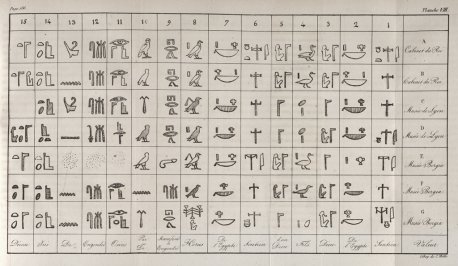Précis du système hiéroglyphique des anciens
Hieroglyphs
Précis du système hiéroglyphique des anciens [ edit ]
Generally hailed as the father of modern Egyptology, Jean-François Champollion was a brilliant philologist from Grenoble who published the first coherent explanation of the ancient Egyptian hieroglyphic script. Following the example of Athanasius Kircher, Champollion intensively studied the Coptic language—along with many others—while researching Classical and Biblical accounts of Egyptian history, religion, and toponymy.
Champollion enjoyed certain advantages over Kircher. With the publication of the Description de l’Égypte, thousands of hieroglyphic inscriptions became available for scholarly consultation, presented in generally reliable facsimile copies. Most important, of course, was the Rosetta Stone, a royal decree published in three scripts—Hieroglyphic, Demotic, and Greek—containing the name of king Ptolemy V Epiphanes, clearly marked in royal cartouches.
By 1819, the English scholar Thomas Young had deciphered the names of Ptolemy and certain queens, correctly recognizing the fundamentally phonetic nature of the hieroglyphs. Yet his proposed sign-values were not all correct, so his attempts to explain the rest of the Rosetta Stone were less convincing.
In 1822, Champollion published his Lettre à M. Dacier, in which he refined Young’s results and, furthermore, recognized the cartouches of numerous foreign rulers of Egypt—from Alexander the Great to Antoninus Pius—which covered the walls of the Graeco-Roman temple published in the Description de l’Égypte. These results were uncontroversial, since most scholars since Kircher had maintained that the phonetic system began in the Graeco-Roman period.
Champollion’s most important discovery appeared in the relatively short Preçis (1824); the comprehensive Grammaire égyptienne (1836) and Dictionnaire égyptien (1841) only appeared posthumously. Using the phonetic values he had established previously, Champollion was able to identify the names of numerous Egyptian rulers (for example, Ramesses, Thutmosis, Sheshonq, and Psamettichus) who predated the Macedonian conquest, proving that the hieroglyphic script was essentially phonetic, not symbolic, already in the Pharaonic Period. In addition, Champollion recognized numerous Coptic words and grammatical elements written phonetically in hieroglyphs, laying the groundwork for the complete decipherment of the ancient Egyptian language.
Armed with this new philological insight, Champollion understood the need for more accurate epigraphic copies of hieroglyphic inscriptions, and set out on his first and only expedition to Egypt in 1828. The joint Franco-Tuscan mission, co-directed by Ippolito Rosselini, focused heavily on the pre-Ptolemaic monuments in Upper Egypt. Champollion passed away shortly after his return to France in 1832, and the results of his expedition were not published for another decade.
The plate of Summary of the hieroglyphic system contains seven copies of the same hieroglyphic text, which Champollion translates as "Support of Egypt, the god, son of a god, the support of Egypt, Horus, who comes forth from Osiris, engendered by Isis, the goddess." The words that Champollion here rendered "support of Egypt" actually translate "greetings to you!," but all of the other words are translated correctly. Champollion's posthumously published Egyptian Grammar (Grammaire égyptienne) appeared in 1836 and would pave the way for future scholars to study Egyptian hieroglyphic and hieratic texts.
Date
1824
Dimensions
H. 23 cm, W. 15.2 cm
Artist or Author
Jean-Francois Champollion
Provenance
France
Museum
Beinecke Rare Book Library
Accession Number
2005 895
Adkins, Lesley and Roy. The Keys of Egypt: the obsession to decipher Egyptian hieroglyphs. New York: Harper Collins, 2000.
Robinson, Andrew. Cracking the Egyptian Code: the revolutionary life of Jean-Fran<cedilla>cois Champollion. New York: Oxford University Press, 2012.



